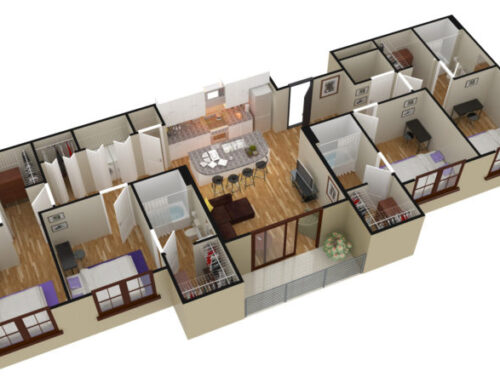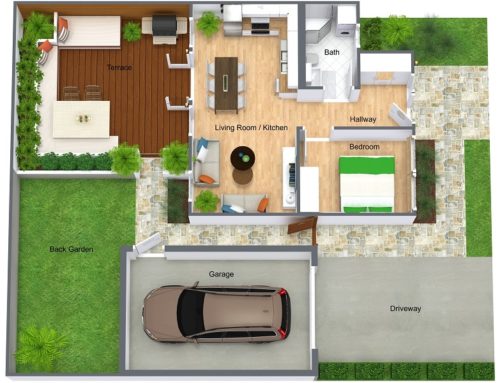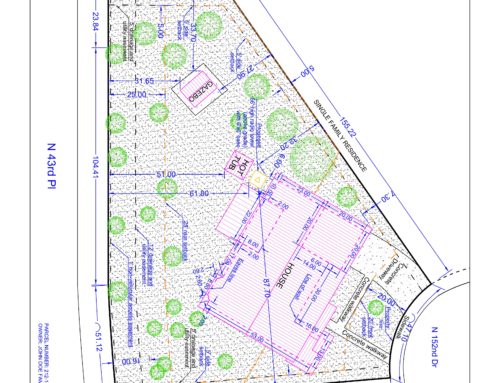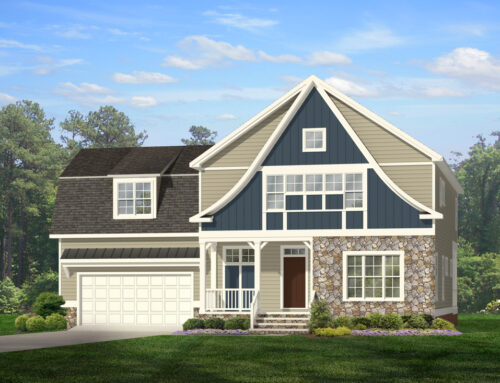According to the King County Permitting Division, a site plan must be obtained any time a residential building permit is required.
For example, if you are planning to build a new deck that is more than 18 inches above the ground on your property in Seattle (or 30 inches above the ground for unincorporated areas within King County), you will need to obtain a building permit, which requires a site plan.
In fact, most residential and commercial construction projects and land use permits in Seattle and throughout King County will require a site plan. For example, if you are looking to obtain a construction permit or a Land Use (Master Use Permit) in Seattle, you will need to submit a site plan with your application.
Note that minor repairs and alterations costing six thousand dollars or less in a six months period, don’t require a building permit, hence there is no need to submit a site plan for a minor repair or alteration such as repainting a wall, conducting basic landscaping work, or repointing a chimney.
Tip: you will, however, need a building permit and a site plan for any work on load-bearing walls and supports, changes to the building envelope, and work that reduces egress, light, ventilation, or fire resistance no matter how small the project may be.
Note: Here’s how we can help: 24hplans has a team of highly-trained, professional architects and drafters who can prepare any kind of site plan in the shortest amount of time possible, so that you can easily obtain that building permit and get on with your project. Use the promotion code: 24hplans-20off to get a 20% discount off any package. — Please note this is a limited time offer, exclusive to the readers of our blog. This offer is not being advertised anywhere else.
This guide will help you get a site plan that cities like Seattle, Bellevue, Federal Way, Redmond, Renton, Kirkland, Kent and other cities in King County require for developing land, building a new house, or remodeling the existing property. If your city or town doesn’t have a planning department, then a King County site plan is still needed for most projects. The terms “site plan”, “plot plan” and “concept plan” are used interchangeably. — You will likely encounter the terms when reviewing the documents or hear it when discussing your plans with an architect or public official in King County, WA.
The topics covered in this guide:
- What a site plan is
- When to get a site plan
- Where to submit the site plan
- What a King County site plan or local project plot plan must include
- How to get a site plan or plot plan
- Getting your building permit application approved
What is a Site Plan?
The details are spelled out below in the Requirements section, but in short, a site plan or plot plan is a scale drawing of your property, its boundaries and structures and other natural and man-made features. The purpose of the site plan is to depict proposed changes to show that they will meet codes and other requirements.
While having a site plan created for your property, submitting it and waiting for approval may seem like a major hassle, an approved site plan or will protect you against future complaints from neighbors, the city or county.
It’s also worth noting that you don’t have to create your own site plan. One can be produced for you quickly and affordably by 24h Plans Drafting Professionals specializing in site plans. This ensures your site plan will meets specific King County plot plan and building permit requirements. A simple and quick way to get your building permit application approved quickly so there are no unnecessary delays in the planned property improvements and alterations.
When to Get a Site Plan
According to the King County Services and Permitting Division, a site plan must be obtained almost any time a building permit is required.
Where to Submit a Site Plan
Where you submit the site plan is quite simple with one small exception. If your city has a planning department, that’s where you should submit the site plan. The department might be called “planning and development,” “planning and zoning” or similar terms.
For example, when applying for a building permit application in Seattle, you will submit your application to the Seattle Department of Construction and Inspections.
Tip: You can complete the Building & Land Use Pre-Application online using the Seattle Services Portal. You will need to upload a site plan.
What a Site Plan Must Show/Site Plan Requirements in Seattle, King County WA
Seattle’s Department of Construction and Inspections accepts three different kinds of Site Plans; Preliminary, Basic, and Enhanced, depending on the project type and stage of the application for the building permit. In the preliminary stage, a preliminary site plan can be used.
The following information is required for the Preliminary Site Plan in Seattle:
- Address of project
- Owner’s name
- Legal description of the property, including any
easements and project numbers of short plats or lot
boundary adjustments - King County Assessor’s parcel number (property tax
account #) - King County recording number for any easements
or other pertinent legal features - North arrow pointing to the top of sheet and consistent across all sheets.
Property lines, dimensions and bearings - Dimensions and right-of-way limits in addition to
roadway widths of adjacent streets (by name), alleys
or other adjacent public property - Curbs, sidewalks, and street trees: type, location,
and dimensions - Street and alley improvement type (asphalt, concrete, gravel, etc.)
- The boundaries of steep slopes, steep slope buffers, wetlands, wetland buffers, riparian management areas, and any other ECA areas, per Tip103B, Environmentally Critical Area Site Plan Requirements.
- SDCI building identifiers for sites with more than one
building - Location of the pedestrian path to each dwelling
unit and the primary entrance to each building. - If existing or proposed building structures (e.g:
building overhangs, chimneys, gutters, sky-bridges,
tunnels, underground parking, etc.) extend into,
over, or under the ROW, a utility easement, or
known utility for which there is no easement, the
dimensions of these structures and their locations
must be provided. - Location and dimensions of all driveways, parking
areas, and other paved areas (existing and proposed) - General location, size, and shape of any structures
presently on the site and of those proposed for construction; including buildings, retaining walls, patios,
decks, porches, rockeries, and driveways (existing
and proposed) - For existing and proposed structures, the front, side
and rear distances from structures to property lines, and
distances between structures, porches and decks. - For projects subject to the provisions of SMC
Chapter 25.11, Tree Protection, show location,
species, stem diameter at 4.5 feet above the
ground (DSH), and dripline (basic Tree protection
Area) labeled “No Disturbance Area” for all trees at
least six inches DSH.
Basic Site Plan
The information listed below is sufficient for site plans
submitted for the following types of projects:
• Small commercial alterations and additions
• Change of use not affecting parking, truck loading,
vehicle access
• Residential (one- and two-family dwellings) additions
and alterations and detached accessory structures
less than 2,000 square feet in area without new vehicular access
Include everything required on the preliminary site plan,
as well as the following information, to create a basic
site plan.
The following information is required for a Basic Site Plan:
In addition to the items required for a preliminary Site Plan, the Basic Site Plan will require the following eleven items:
19. The drawing’s scale (min. 1″ = 10′).
20. Specific location, size, and shape of all existing and
proposed structures, including buildings, retaining walls,
patios, decks, porches, rockeries, and driveways.
21. A location plan is required when repair and/or minor
interior alteration to an existing structure
is proposed.
22. Street and alley improvement dimensions.
23. Include site lot coverage calculations.
24. Identification of proposed work, including proposed
changes to the physical features of the site or existing
structures. Clearly distinguish between existing and
proposed features. Statements such as “Existing
wall to remain” are acceptable call-outs.
25. Location and dimension of all window wells, fireplaces, chimneys, etc.
26. Center elevation and developed roadway at 25-foot
intervals if a change to access or parking is proposed.
27. Identify existing and finished grade elevation of
driveway at property line, and at garage entry, if a
change to access or parking is proposed
28. Curb cut width and distance from adjacent property
lines. (Label curb cuts as “existing” or “proposed.”)
29. Identify all physical restrictions to site access (utility
poles, rockeries, street trees, Metro bus stops, etc.)
if a change to access is proposed.
Enhanced Site Plan
Include everything required on the preliminary and basic
site plans. Numbers 30-44 are additional items required
for an enhanced site plan.
The following information is required:
30. Elevations and contour lines with labeled contour
intervals on sloping sites or where earth grading is
proposed (2-foot intervals).
31. Identify top and bottom of steep slopes (as defined
in SMC 25.09) and show dimensions from slope
top/bottom to the building(s).
32. Identify drainage ditches, natural watercourses, and
culverts.
33. All proposed and existing street trees and other
landscaping in the public right-of-way.
34. Sewer mains (sanitary only {PPS} and/or combined
sewers {PS}).
35. Storm drains {PSD}, catch basins, and inlets.
36. Water mains, fire hydrants, and water meters.
37. Power poles, street lights, signal and transit poles,
overhead system, bus zones, street signs, etc. adjacent to the subject property.
38. All other elements between the pavement edge and
property line (such as side sewer, electrical ducts
and vaults, electrical conduits, handholes, ditches,
culverts, curb ramps, etc.).
39. On-site stormwater treatment, infiltration, or detention systems.
40. Calculations demonstrating compliance with applicable Land Use Code development standards.
41. For street improvement plans (SIPs) refer to the City
of Seattle’s standard plans. Standard plans 002 and
003 provide information related to standard symbols
and abbreviations, which are required when submitting plans to SDOT.
From the list of requirements above, it’s easy to see why most homeowners in Seattle use a professional service such as 24h Plans to produce their King County site plans. Your site plan must be submitted to the Seattle Department of Construction & Inspections along with building plans that meet another set of specific requirements.
How to Get a Site Plan
You can successfully produce your own site plan, but keep in mind that it must be accurate, drawn to scale and include a long list of components.
Most homeowners have their proposed site plans professionally drafted. Site plan and land survey services are also offered by some architects, land surveyors, and civil engineering firms, but the cost is typically between $300 and $1,200 for a certified site plan due to hourly rates for these services of $100 to $200 per hour.
A more affordable way to have a site plan for Seattle, Kirkland, Bellevue, Redmond, etc., drafted is to get one online from 24 hour Site Plans.
How to get your building permit application approved
Prepare a basic site plan that meets all of the Seattle’s Basic Site Plan requirements listed above. The team at 24h Plans can produce a basic site plan for you within 24 hours.
Armed with a site plan, you can complete the Building Permit and Land Use Pre-Application online using the Seattle Services Portal. You will need to upload a site plan.
For unincorporated areas within King County, you can submit your building application online at KingCounty.gov
Work with an experienced builder and developer who knows the ropes of the building application process, and more importantly, will complete your project in accordance with the local building code requirements.
Note: Here’s how we can help: 24hplans has a team of highly-trained, professional architects and drafters who can prepare any kind of site plan in the shortest amount of time possible, so that you can easily obtain that building permit and get on with your project. Use the promotion code: 24hplans-20off to get a 20% discount off any package. — Please note this is a limited time offer, exclusive to the readers of our blog. This offer is not being advertised anywhere else.







Leave A Comment